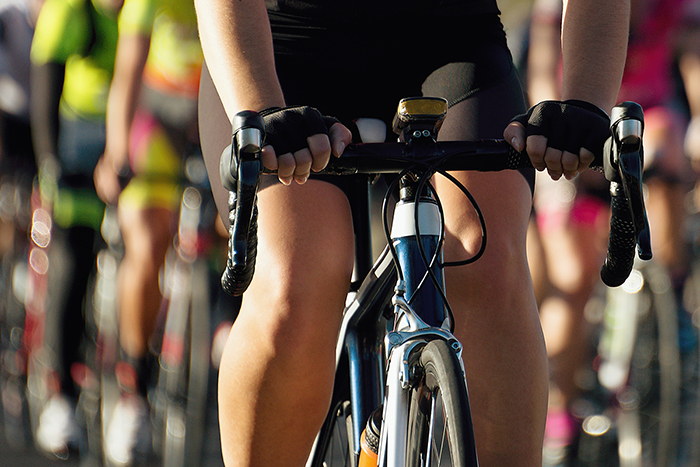Have a Fit, or Two, for Pain-Free Biking

Making sure your bike and helmet fit properly helps keep you injury free.
Cycling can be a real pain in the neck. And back. And knees.
But it doesn’t have to be.
A lot of it comes down to if you’re fit – and how you sit.
Seated on a bike, “you’re in a unique position,” says Dr. Carolyn Kienstra, one of the leaders of the University of Miami Sports Medicine Institute’s Endurance Program. “It’s not a position that most people spend much time in, normally. And when you’re on the bike, you can spend a long time in that position. So it can definitely affect everything from your neck and back to your knees and hips and ankles.”
In its defense, biking can offer health benefits like no other. It’s great for your lungs and legs and heart. Road biking also avoids the joint-jolting impact of other forms of cardio (I’m looking at you, running).
But, oh, riding can still make you suffer. From your head to your toes – literally.
OH, MY ACHING …
Neck: If your neck hurts, it could be your hands’ fault. Or, more precisely, your handlebar’s. Improper positioning can affect your alignment and force you to constantly crane your neck so you can see where you’re going and watch out for cars (which is always important, but we’ll get to that in a minute).
There’s even a thing called Shermer’s neck, named after the poor schmo whose neck muscles got so strained in the 3,000-mile Race Across America that they flat gave out. His teammates had to construct a brace out of bungee cords to hold his head up. Really.
Back: Back pain could be your butt’s fault. As in where you put it. If the saddle’s too low, it could cause compression injuries. Too high and you could end up overstretching.
Then again, it could be you. Flaws in posture and stability take their toll. Forward bend in the lumbar can lead to lower back pain.
Knees: Your butt could be to blame here, too. If the pain is in the back of the knee, anyway. If your seat’s too high, it throws off the dynamics of your leg muscles. Overextension affects flex, which equals pain.
Front of the knee? Your butt again. Too low this time. Or too far forward. That can cause tightness in the hamstring or the Iliotibial band. The results are the same. A tight hamstring can make the quadriceps overcompensate, tugging the patella – the kneecap – wrong. A tight or inflamed Iliotibial band does the same thing.
Feet: It could be your cleats or pedals. If the ball of the foot doesn’t line up right, it can put excess pressure on your toe flexors. That, in turn, can overtax the plantar muscle. Do it enough and, bingo, you got foot arch ouch!
MAKING IT PAINLESS
The fix to almost all of the above: Getting your bike fitted to you. Go to a pro, says Kienstra. The people at a good cycling shop can help you set up your bike so it’s right for you. And they’ll do it again and again if they have to.
“You want the right position – a position that doesn’t cause pain for you,” she says. “Really it’s a dynamic process. You need someone that you feel like you can go back and forth to a couple of times and say, ‘You did this bike fit but I rode and my back really hurt. What can we adjust?’”
Your fitness counts, too.
A strong core – abs, back, and glutes – are key, says Kienstra: “keeping all of that strong so that you can maintain that stability and good posture while you’re on the bike.”
HEAD-ACHES
But none of that matters if you don’t take care of your head. Concussions, or worse, are a real possibility if you fall off your bike. Or if you get hit by a car.
So wear a helmet. Always.
At any age.
“A kid who learns at a young age to wear a helmet and that’s just part of biking, just like brushing your teeth, then it’s a lot easier when you’re an adult and the first thing you do is put on a proper helmet,” says UHealth’s Dr. Gillian Hotz, PhD, director of the KiDZ Neuroscience Center and the Concussion, WalkSafe and BikeSafe programs.
Keyword: proper. That means it fits right, too.
“The helmet has to fit well and you can’t have it leaning too far forward or too far back,” she says. “You have to have the two-finger rule. Two fingers above your eyebrows and your ear. Your chinstrap has to be set up properly and snug.”
And play it safe.
Follow the rules of the road. Stop for lights and stop signs. Signal when turning. Traffic laws apply to you, too.
Be visible. Be predictable.
And, always – Always! – watch out for cars. They may not be watching out for you.
Tags: bicycle, biking, Dr. Carolyn Kienstra, Dr. Gillian Hotz, injury prevention, University of Miami Sports Medicine Institute
